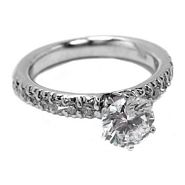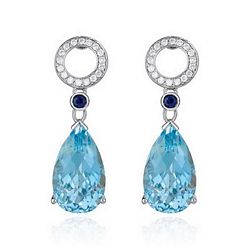Diamond Cuts
NO ADSENSE ACCOUNT SELECTED FOR
GOOGLE ADSENSE
Ask any diamond expert the question, “What makes a diamond sparkle?” And they will tell you without hesitation, the cut! No matter what clarity grade or color a diamond has, it will not show forth its true beauty unless it is cut with skilled precision.
Take note diamond buyers: The cut, made by a masterful gemologist is what makes a diamond fiery, brilliant and valuable.
If a diamond is not well cut, not only will it not sparkle, its value will be greatly diminished
What is a Diamond Cut? It refers to the diamond's symmetry, proportions and polished finish.
The Cut of a Diamond In their most natural form, diamonds are well quite ugly. They have no luster or shine, and in fact, look like nothing more than broken glass. A diamond must be cut, and then polished before it actually becomes a thing of beauty.
Diamonds are cut with saws, into round shapes. From the rounded shape, other shapes may be cut, such as heart shapes but the shape is less important than the quality of the cutting that is being done.
If the diamond is poorly cut, it will lose light, and it will not sparkle and shine very well. Each facet of the diamond must be carefully cut into the geometrical shapes that allow the diamond to sparkle and shine, then the entire diamond is cut into a specific shape, such as an emerald cut or a princess cut diamond.
Once the cut is done, the diamond is put into a dop, which resembles a cup with another diamond only a diamond is strong enough to smooth the edges of another diamond. Once the diamond has been cut and shaped, and the edges smoothed in the dop, it is polished on a scaif or a diamond polishing wheel.
Diamond Cut Related Terms
BrillianceIs what differentiates the diamonds ability to reflect light from those lesser abilities found in other gemstones.
CrownFor a round diamond, in order for the crown to provide sufficient fire, the bezel facets should be cut within a specific range of angles (usually between 33 and 35 degrees). However, this range is merely a guideline, not a hard-and-fast rule that must be adhered to in every case.
At the outer points of this range, you might find diamonds with crown angles of as little as 31.5 degrees and as much as 35.9 degrees which are still very attractive. These angles do not affect the diamond's table percentage in any way. It is possible for a diamond's crown to have any combination of crown angles and table size that a cutter desires.
DispersionIs defined as the facets, and the angles at which a diamond is cut. The way they have been skillfully designed to break up white light as it hits the surface, separating it into its component spectral colors-red, blue, green etc. This effect, which appears as a play of small flashes of color across the surface of the diamond as it is tilted, is also called "fire."
FinishFinish is the quality imparted to a diamond by the direct skill of the diamond cutter. The term "finish" entails every aspect of a diamond's appearance that is not a result of the diamond's natural existence when it is recovered from the ground.
The diamond's design, the precision of its cutting details, and the quality of its polish are all a consideration when a gemologist is grading finish. If you examine a diamond's grading report, you will see its finish graded according to two separate categories: polish and symmetry.
PolishIs defined as any blemish on the surface of the diamond not significant enough to affect clarity.
Polished FinishedThe finish is the precision of the cut, the condition of its girdle and the quality of a diamond’s polish.
ProportionProportions determines a diamond's optical properties. It refers to the angles and relative measurements of a polished diamond. The best cut diamonds reflect light back to the eye evenly in the face-up position; here there no dark areas are visible. Dark or 'dead' areas are due to poor cutting.
When a diamond is well-cut (either a fine cut or an Ideal cut), light enters through the table and travels all the way to the pavilion where it reflects from one side of the diamond to the other - intensifying in the mirror-like facets as it travels - before reflecting back out of the diamond through the table and into the observer's eye. This brightness that should come from the very heart of a diamond is known as brilliance.
ScintillationIs defined as the ability to reflect and return white light to the eye. Creating those quick flashes of light you see as a person tilts the diamond back and forth during normal movement.
SymmetrySymmetry is a term that refers to the placement and alignment of a diamond's facets and its flat and polished surfaces. The facets should be cut to achieve the best reflection of light.
Small variations can include misalignment of facets or facets that fail to point correctly to the girdle (this misalignment is completely undetectable to the naked eye). Symmetry problems are indicative of diamonds graded as fair or poor.
TableThe table is the largest and top-most facet on the diamond's crown. The table percentage is the value, which represents how the diameter of the table facet compares to the diameter of the entire diamond. For example, if a diamond with a 55% table has a table which is 55% as wide as the diamond's outline.
For a round diamond, gemologists calculate table percentage by dividing the diameter of the table, which is measured in millimeters (this millimeter measurement does not appear on diamond grading reports) by the average girdle diameter (an average of the first two millimeter measurements on the top left-hand side of a diamond grading report).
For a fancy shape diamond, table percentage is calculated by dividing the width of the table, at the widest part of the diamond, by the millimeter width of the entire stone (this total width measurement is the second of the three millimeter values in the top left-hand corner of the diamond grading report. The Table measurements are subtleties, which vary ever so slightly and should not become a pre-occupation in your diamond selection.
Diamond Cut Facts:
Without attention to quality cutting, light is lost and not returned to the eye. Go back to: The Buying Diamonds Guide. Go back to: The 4 C's of Diamonds Source: Vicente Ross, DiamondExperts.biz
|
Diamonds Are Forever
Buying Diamonds Guide | Diamond Rings | Diamond Earrings | Diamond Engagement Ring
Wedding Rings | Black Diamonds | Blue Diamond Ring | Diamond Bracelet | Tiffany Diamonds
Loose Diamonds | Fake Diamonds | Famous Diamonds | Bonded Diamonds | Colored Diamonds
Wholesale Diamonds | Platinum Wedding Ring | Diamond Solitaire Ring | Yellow Diamonds
Diamond Jewelry Resources
Jewelers Vigilance Committee | Gemological Institute of America | The Jewelers Board of Trade
American Institute Of Diamond Cutting
|
Blood Diamonds |
Stop Blood Diamonds
Join Stop Blood Diamonds |
Diamond Glossary |
Diamond FAQs |
Diamond Mine
The 4 C's of Diamonds | Diamond
Appraisal | Diamond Certificate
Fine Jewelry Resources
How To Find a
Great Jewelry Repair Shop | How To a Avoid Jewelry Repair
Fiasco | The Jewelry Repair
Guide
Man Made Diamonds
Apollo Diamond | CARAT
| Cubic Zirconia | Diamond Nexus |
Gemisis Cultured Diamond
Moissanite Jewelry | Russian
Diamonds | Swarovski Crystals |White
Sapphire
DIAMONDEXPERTS.BIZ is the leading diamond jewelry and fine jewelry resource on the Internet. We
provide up to date information on all types of diamonds and associated jewelry. Our primary mission is to help you
find the best deal possible on genuine diamond jewelry.
Copyright © Diamond Experts 1997-2012 All Rights Reserved.
Privacy Policy
Powered by the Buy Jewelry
Online
Diamond Experts
Diamond Cutters and Polishers, Goldsmiths, Top-Tier Designers and Diamond
Setting Masters
Antwerp Jewels & Diamond
Manufacturers
Antwerp / Belgium / Brazil / Canada / Europe / Italy / USA and
Worldwide



 Facebook
Facebook Twitter
Twitter Delicious
Delicious Livejournal
Livejournal Reddit
Reddit Stumbleupon
Stumbleupon Yahoo My Web
Yahoo My Web Google Bookmarks
Google Bookmarks BlinkList
BlinkList Digg
Digg Blogmarks
Blogmarks Diigo
Diigo Fark
Fark Ma.gnolia
Ma.gnolia Netvouz
Netvouz Newsvine
Newsvine Slashdot
Slashdot Spurl
Spurl Technorati
Technorati Wists
Wists